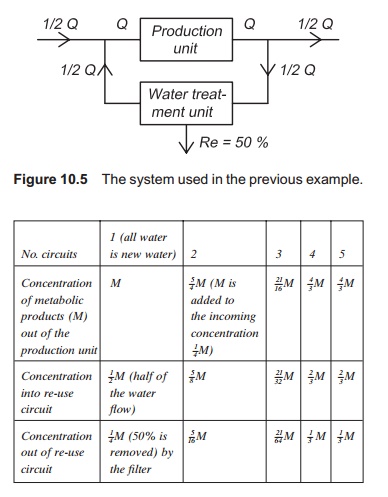Chapter: Aquaculture Engineering : Recirculationand Water Re-use Systems
Connection between outlet concentration, degree of re-use and effectiveness of the water treatment system
Connection between outlet concentration, degree of
re-use and effectiveness of the water treatment system
When starting up a re-use system
the concentration of substances in the system will gradually increase until it
is stabilized at a given level.
Example
A simple re-use system uses a degree of re-use of 50%; a filter
with 50% efficiency is installed in the re-use circuit (Fig. 10.5). Show how
many times the water must circulate in the re-use system before the system is
in balance (this condition is assumed as ideal) regarding the concentration
level of metabolic products, presented as parts of M.

As shown, the system will be stabilized when the water has
completed four circuits.
An equation to determine the
concentration in the tank outlet in a re-use system (C) compared to the outlet concentration in a flow-through tank has
been developed. This is based on the degree of re-use (R) and the removal efficiency (re) of
the filter system in the circuit and is as follows:
C =1/(1− R +(R re))
Example
A system has a degree of re-use of 96%, while the removal
efficiency is 50%. Calculate the concentra-tion in the outlet of the system
compared to a tradi-tional flow-through system.
C =1/(1−0.96+(0.96×0.5)) = 1.92
This means that the concentration of substances is 1.92 times
those from a flow-through system. For instance, if the flow-through system had
an SS con-centration of 20 mg/l in the outlet, the concentration in the re-use
system will be 20 × 1.92 = 38.4 mg/l. If the maximum concentration that the fish tolerate
without growth reduction is 25 mg/l, the re-use system is not useful because
the SS concentration is too high. Either a better filter must be installed or
the degree of re-use must be lowered, which means greater dilution by adding
more new water.
Based on this, it is possible to calculate how much new water
has to be added to have a system that functions. First the maximum allowed SS
concen-tration Cmax, is found:
Cmax=25/20=1.25 mg/l
Then this value substituted in the formula and in the equation
solved for the degree of re-use (R):
C =1/(1− R + R re)
1.25 = 1/(1 −R+ 0.5R)
R =0.4
This means that the maximum degree of re-use that can be used is
40% and 60% of new water must be added. In practice, however, a better filter
unit will be installed instead of adding so much new water.
The general formula is as
follows:
C =(1/(1− R + R re))Mf/Qout
Where Mf/Qout
represents the outlet concentration in a flow-through system. By rearranging
this equation it can be used to find the necessary efficiency of a filter
system, based on acceptable outlet concentrations and degree of re-use. The
equation may also be rearranged and solved to find the accept-able degree of
re-use when a filter system has been chosen.
If the inlet water contains the
substances in question, their concentrations must also be added to the
equation. The mass of substances in the new inlet water (Mi) must be calculated using the mass balance equation
and be added to Mf. This
can be expressed as CinQi, which gives the following
equation:
C =(1/(1− R + R re))(Mf+(CinQi))/Qout
Related Topics